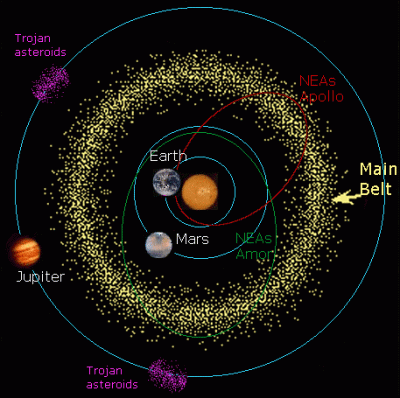
Between the planets Mars and Jupiter lies the asteroid belt. It is home to tens of thousands of asteroids. These rocky objects are leftovers from the early Solar System, and are too small to be considered planets. They come in different shapes and sizes with the smallest being less than 1 km (0.6 miles) wide. Some asteroids have moons and one even has rings!
Most of the asteroids in the Main Belt are made of rock and stone, but a small portion of them contain iron and nickel metals. The remaining asteroids are made up of a mix of these, along with carbon-rich materials. Some of the more distant asteroids tend to contain more ices. Although they aren’t large enough to maintain an atmosphere, but there is evidence that some asteroids contain water.
Some asteroids are large, solid bodies — there are more than 16 in the belt with a diameter greater than 150 miles (240 km). The largest asteroids, Vesta, Pallas and Hygiea, are 250 miles (400 km) long and bigger. The region also contains the dwarf planet Ceres. At 590 miles (950 km) in diameter, or about a quarter of the size of our moon, Ceres is round yet is considered too small to be a full-fledged planet. However, it makes up approximately a third of the mass of the asteroid belt.
Other asteroids are piles of rubble held together by gravity. Most asteroids aren’t quite massive enough to have achieved a spherical shape and instead are irregular, often resembling a lumpy potato. The asteroid 216 Kleopatra resembles a dog bone.
Asteroid orbits
Not all of the asteroids in our Solar System are found in the asteroid belt. Some asteroids pass near other planets, including Earth. Asteroids that come close to Earth are called Near Earth Objects. The planet Jupiter even shares its orbit around the Sun with two groups of asteroids, which are called Trojans. If something slows an asteroid, it may “fall” towards the Sun, towards Mars, or towards Jupiter. As both Jupiter and Mars move past the asteroids in their orbits, they may be pulled slightly towards those huge bodies in their orbits. In fact, Phobos and Diemos, the two tiny moons of Mars, may be captured asteroids. Some scientists believe that the asteroid belt was made when a planet that was there exploded or collided with something else and broke up. Other scientists believe that the material making the asteroids never came together into a planet at all.
Craters
Craters are nicknamed “Snowman” because they look just like a snowman! They are on Vesta, one of the largest asteroids in the asteroid belt.
Many impact craters are found on the Earth’s surface, although they can be harder to detect. One of the best-known craters on Earth is Meteor Crater, near Winslow, Arizona. The crater was created instantly when a 50-meter (164-foot), 150,000-ton meteorite slammed into the desert about 50,000 years ago. Meteor Crater is 1.2 kilometers (0.75 miles) in diameter and 175 meters (575 feet) deep.
Impact craters are found on most of the solar system’s rocky planets and moons. The so-called “gas giants” of the solar system—Jupiter, Saturn, Uranus, and Neptune—don’t have craters. These planets are made up almost entirely of gases, so there is no hard surface for a meteor to impact. Meteors entering the atmosphere of a gas giant simply break up.
Cratering is a rare occurrence in the solar system today. Planets, moons, comets, and other celestial bodies have fairly stable orbits that do not interact with each other. Meteors do collide with planets—including Earth—every day. However, most of these meteors are the size of a speck of dust and do not cause any cratering. Most meteors burn up in the atmosphere as “shooting stars” before ever colliding with the surface of the Earth.
Ceres
By far the largest object in the asteroid belt is Ceres. Made mostly of rock is Ceres. Made mostly of rock and ice, it was the first asteroid ever discovered. It has since been classed as a Dwarf Planet, because it is more like a planet than its neighbours in the main asteroid belt.
Ceres takes 1,682 Earth days, or 4.6 Earth years, to make one trip around the sun. As Ceres orbits the sun, it completes one rotation every 9 hours, making its day length one of the shortest in the solar system.
Ceres’ axis of rotation is tilted just 4 degrees with respect to the plane of its orbit around the sun. That means it spins nearly perfectly upright and doesn’t experience seasons like other more tilted planets do.
Ceres formed along with the rest of the solar system about 4.5 billion years ago when gravity pulled swirling gas and dust in to become a small dwarf planet. Scientists describe Ceres as an “embryonic planet,” which means it started to form but didn’t quite finish. Nearby Jupiter’s strong gravity prevented it from becoming a fully formed planet. About 4 billion years ago, Ceres settled into its current location among the leftover pieces of planetary formation in the asteroid belt between Mars and Jupiter.
Picture Credit : Google

